Innovation Strategies and Ocado's Business Development Report
VerifiedAdded on 2023/01/09
|13
|3753
|28
Report
AI Summary
This report provides an in-depth analysis of Ocado's innovation management strategies, focusing on the application of diffusion of innovation theory and blue ocean strategy within the context of the online grocery retail industry. It defines key concepts, processes, and principles of innovation theory, examining how Ocado has leveraged these to gain a competitive advantage. The report also explores the benefits and disadvantages of the blue ocean strategy, providing insights into its practical application and limitations. Furthermore, it details the historical development of Ocado's goods and services, highlighting the company's innovative approach to meeting customer needs and expanding its market share. The report concludes with a discussion of potential future development pathways for Ocado, considering how the company can continue to innovate and maintain its position in the market. The report also includes an examination of the limitations of the innovation strategies and the benefits of using diffusion innovation theory. The report also provides a comprehensive overview of the company's background, including its senior management and leadership using the Blue Ocean strategy for the historical development of their past goods and services.
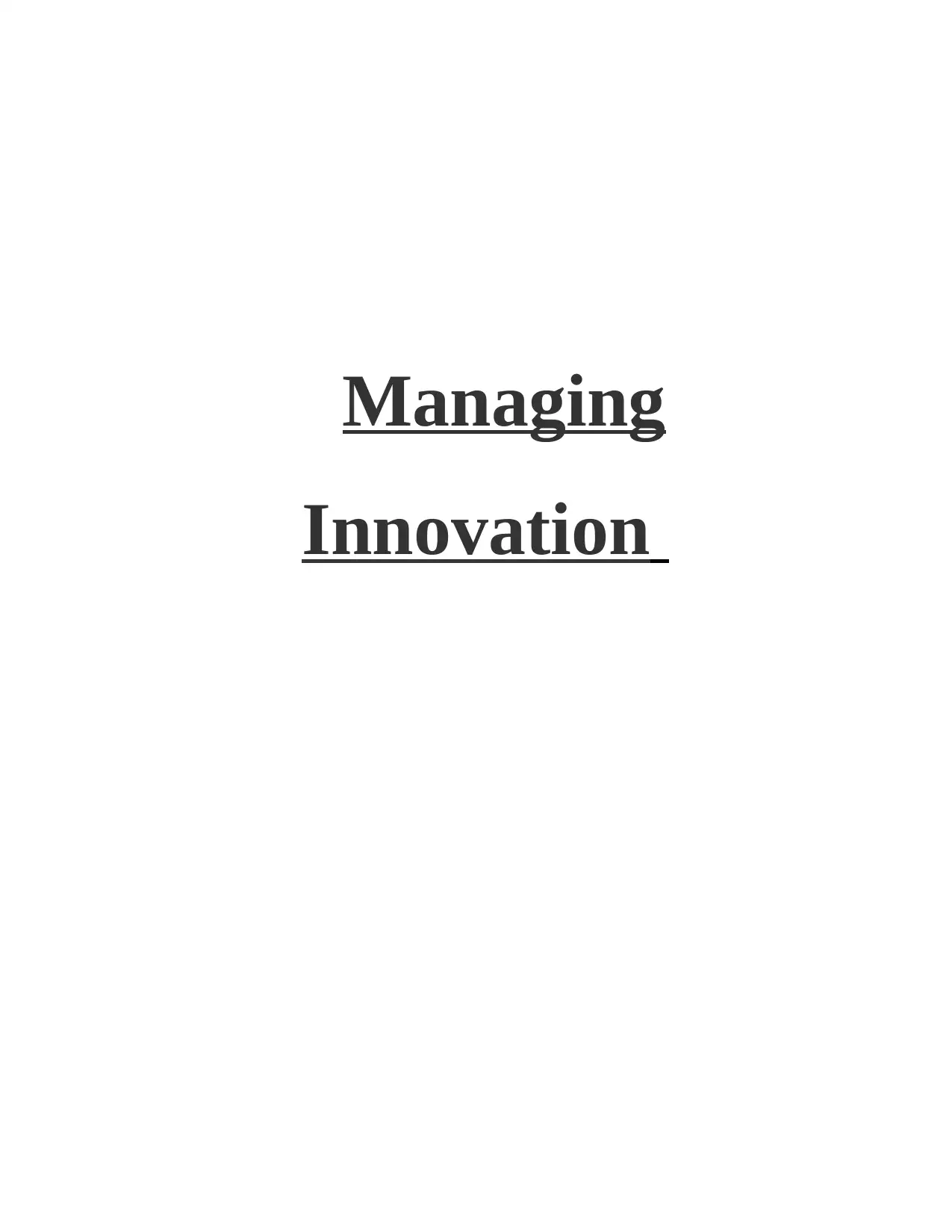
Managing
Innovation
Innovation
Paraphrase This Document
Need a fresh take? Get an instant paraphrase of this document with our AI Paraphraser
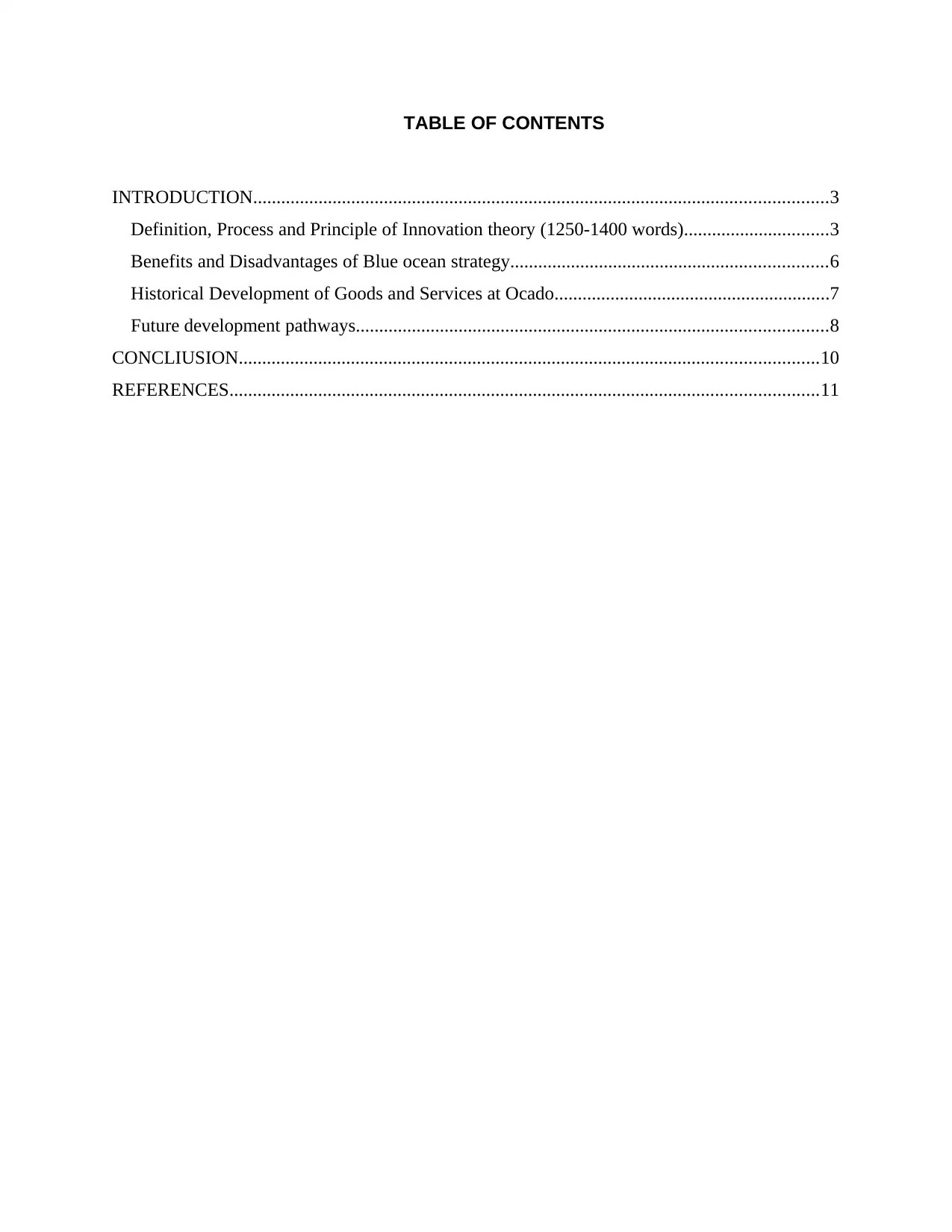
TABLE OF CONTENTS
INTRODUCTION...........................................................................................................................3
Definition, Process and Principle of Innovation theory (1250-1400 words)...............................3
Benefits and Disadvantages of Blue ocean strategy....................................................................6
Historical Development of Goods and Services at Ocado...........................................................7
Future development pathways.....................................................................................................8
CONCLIUSION............................................................................................................................10
REFERENCES..............................................................................................................................11
INTRODUCTION...........................................................................................................................3
Definition, Process and Principle of Innovation theory (1250-1400 words)...............................3
Benefits and Disadvantages of Blue ocean strategy....................................................................6
Historical Development of Goods and Services at Ocado...........................................................7
Future development pathways.....................................................................................................8
CONCLIUSION............................................................................................................................10
REFERENCES..............................................................................................................................11
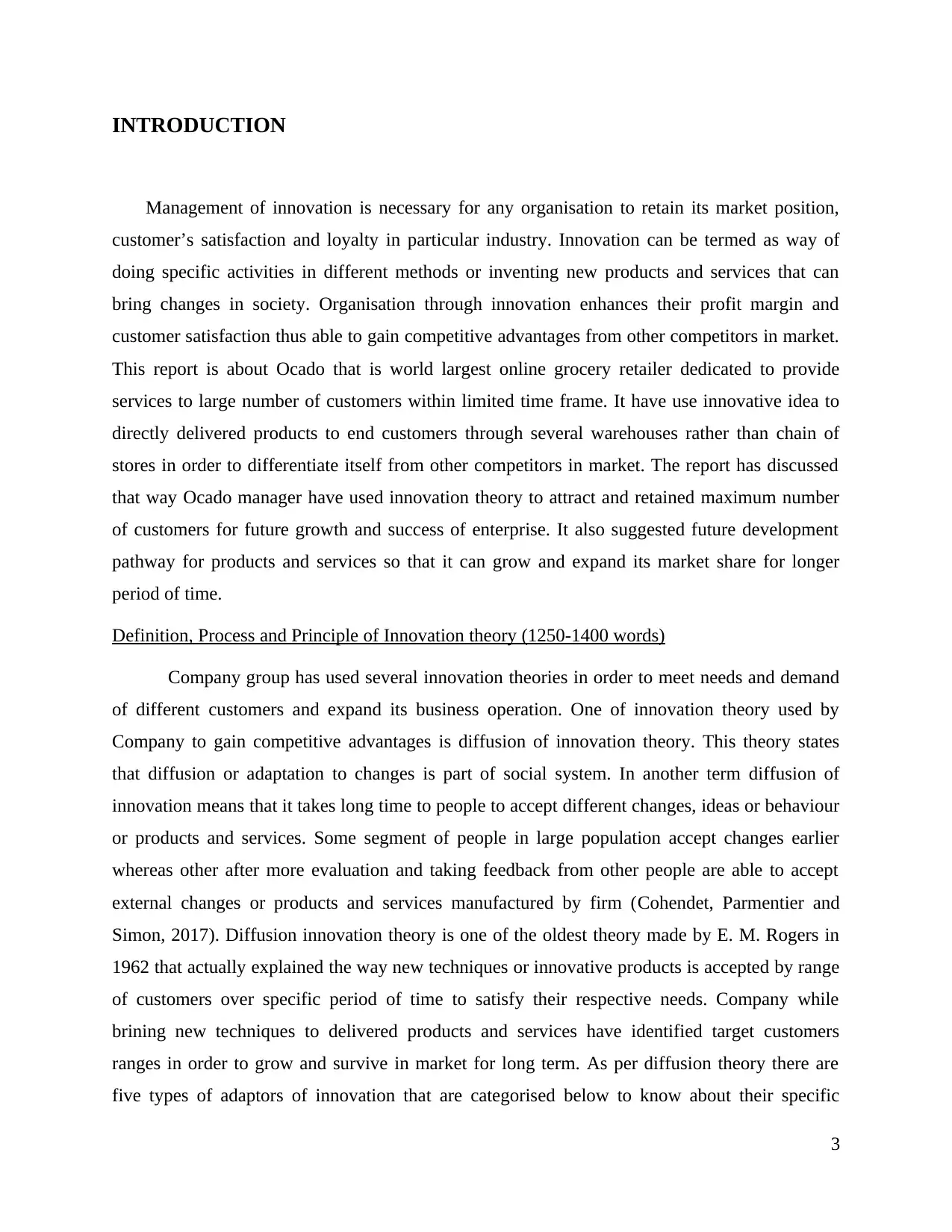
INTRODUCTION
Management of innovation is necessary for any organisation to retain its market position,
customer’s satisfaction and loyalty in particular industry. Innovation can be termed as way of
doing specific activities in different methods or inventing new products and services that can
bring changes in society. Organisation through innovation enhances their profit margin and
customer satisfaction thus able to gain competitive advantages from other competitors in market.
This report is about Ocado that is world largest online grocery retailer dedicated to provide
services to large number of customers within limited time frame. It have use innovative idea to
directly delivered products to end customers through several warehouses rather than chain of
stores in order to differentiate itself from other competitors in market. The report has discussed
that way Ocado manager have used innovation theory to attract and retained maximum number
of customers for future growth and success of enterprise. It also suggested future development
pathway for products and services so that it can grow and expand its market share for longer
period of time.
Definition, Process and Principle of Innovation theory (1250-1400 words)
Company group has used several innovation theories in order to meet needs and demand
of different customers and expand its business operation. One of innovation theory used by
Company to gain competitive advantages is diffusion of innovation theory. This theory states
that diffusion or adaptation to changes is part of social system. In another term diffusion of
innovation means that it takes long time to people to accept different changes, ideas or behaviour
or products and services. Some segment of people in large population accept changes earlier
whereas other after more evaluation and taking feedback from other people are able to accept
external changes or products and services manufactured by firm (Cohendet, Parmentier and
Simon, 2017). Diffusion innovation theory is one of the oldest theory made by E. M. Rogers in
1962 that actually explained the way new techniques or innovative products is accepted by range
of customers over specific period of time to satisfy their respective needs. Company while
brining new techniques to delivered products and services have identified target customers
ranges in order to grow and survive in market for long term. As per diffusion theory there are
five types of adaptors of innovation that are categorised below to know about their specific
3
Management of innovation is necessary for any organisation to retain its market position,
customer’s satisfaction and loyalty in particular industry. Innovation can be termed as way of
doing specific activities in different methods or inventing new products and services that can
bring changes in society. Organisation through innovation enhances their profit margin and
customer satisfaction thus able to gain competitive advantages from other competitors in market.
This report is about Ocado that is world largest online grocery retailer dedicated to provide
services to large number of customers within limited time frame. It have use innovative idea to
directly delivered products to end customers through several warehouses rather than chain of
stores in order to differentiate itself from other competitors in market. The report has discussed
that way Ocado manager have used innovation theory to attract and retained maximum number
of customers for future growth and success of enterprise. It also suggested future development
pathway for products and services so that it can grow and expand its market share for longer
period of time.
Definition, Process and Principle of Innovation theory (1250-1400 words)
Company group has used several innovation theories in order to meet needs and demand
of different customers and expand its business operation. One of innovation theory used by
Company to gain competitive advantages is diffusion of innovation theory. This theory states
that diffusion or adaptation to changes is part of social system. In another term diffusion of
innovation means that it takes long time to people to accept different changes, ideas or behaviour
or products and services. Some segment of people in large population accept changes earlier
whereas other after more evaluation and taking feedback from other people are able to accept
external changes or products and services manufactured by firm (Cohendet, Parmentier and
Simon, 2017). Diffusion innovation theory is one of the oldest theory made by E. M. Rogers in
1962 that actually explained the way new techniques or innovative products is accepted by range
of customers over specific period of time to satisfy their respective needs. Company while
brining new techniques to delivered products and services have identified target customers
ranges in order to grow and survive in market for long term. As per diffusion theory there are
five types of adaptors of innovation that are categorised below to know about their specific
3
⊘ This is a preview!⊘
Do you want full access?
Subscribe today to unlock all pages.

Trusted by 1+ million students worldwide
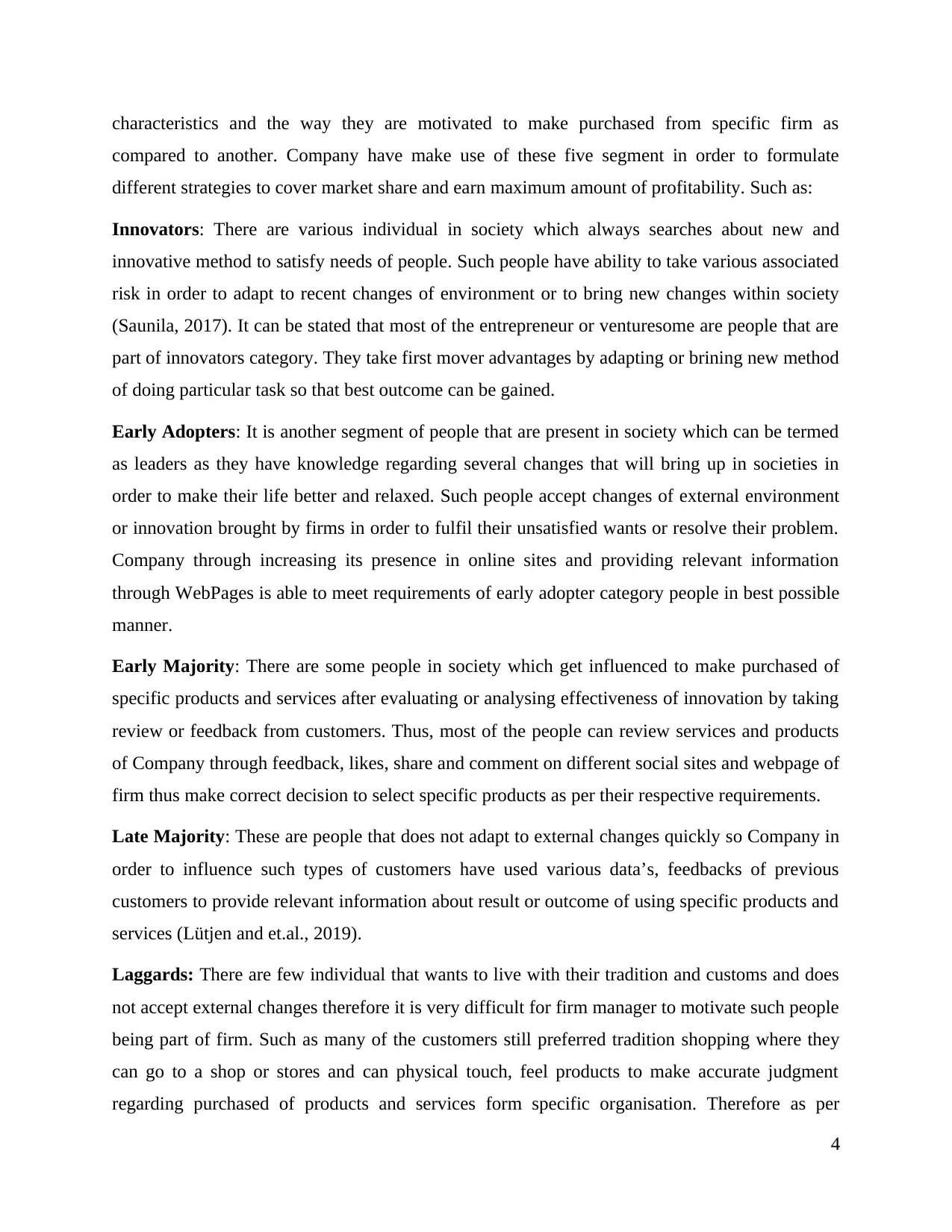
characteristics and the way they are motivated to make purchased from specific firm as
compared to another. Company have make use of these five segment in order to formulate
different strategies to cover market share and earn maximum amount of profitability. Such as:
Innovators: There are various individual in society which always searches about new and
innovative method to satisfy needs of people. Such people have ability to take various associated
risk in order to adapt to recent changes of environment or to bring new changes within society
(Saunila, 2017). It can be stated that most of the entrepreneur or venturesome are people that are
part of innovators category. They take first mover advantages by adapting or brining new method
of doing particular task so that best outcome can be gained.
Early Adopters: It is another segment of people that are present in society which can be termed
as leaders as they have knowledge regarding several changes that will bring up in societies in
order to make their life better and relaxed. Such people accept changes of external environment
or innovation brought by firms in order to fulfil their unsatisfied wants or resolve their problem.
Company through increasing its presence in online sites and providing relevant information
through WebPages is able to meet requirements of early adopter category people in best possible
manner.
Early Majority: There are some people in society which get influenced to make purchased of
specific products and services after evaluating or analysing effectiveness of innovation by taking
review or feedback from customers. Thus, most of the people can review services and products
of Company through feedback, likes, share and comment on different social sites and webpage of
firm thus make correct decision to select specific products as per their respective requirements.
Late Majority: These are people that does not adapt to external changes quickly so Company in
order to influence such types of customers have used various data’s, feedbacks of previous
customers to provide relevant information about result or outcome of using specific products and
services (Lütjen and et.al., 2019).
Laggards: There are few individual that wants to live with their tradition and customs and does
not accept external changes therefore it is very difficult for firm manager to motivate such people
being part of firm. Such as many of the customers still preferred tradition shopping where they
can go to a shop or stores and can physical touch, feel products to make accurate judgment
regarding purchased of products and services form specific organisation. Therefore as per
4
compared to another. Company have make use of these five segment in order to formulate
different strategies to cover market share and earn maximum amount of profitability. Such as:
Innovators: There are various individual in society which always searches about new and
innovative method to satisfy needs of people. Such people have ability to take various associated
risk in order to adapt to recent changes of environment or to bring new changes within society
(Saunila, 2017). It can be stated that most of the entrepreneur or venturesome are people that are
part of innovators category. They take first mover advantages by adapting or brining new method
of doing particular task so that best outcome can be gained.
Early Adopters: It is another segment of people that are present in society which can be termed
as leaders as they have knowledge regarding several changes that will bring up in societies in
order to make their life better and relaxed. Such people accept changes of external environment
or innovation brought by firms in order to fulfil their unsatisfied wants or resolve their problem.
Company through increasing its presence in online sites and providing relevant information
through WebPages is able to meet requirements of early adopter category people in best possible
manner.
Early Majority: There are some people in society which get influenced to make purchased of
specific products and services after evaluating or analysing effectiveness of innovation by taking
review or feedback from customers. Thus, most of the people can review services and products
of Company through feedback, likes, share and comment on different social sites and webpage of
firm thus make correct decision to select specific products as per their respective requirements.
Late Majority: These are people that does not adapt to external changes quickly so Company in
order to influence such types of customers have used various data’s, feedbacks of previous
customers to provide relevant information about result or outcome of using specific products and
services (Lütjen and et.al., 2019).
Laggards: There are few individual that wants to live with their tradition and customs and does
not accept external changes therefore it is very difficult for firm manager to motivate such people
being part of firm. Such as many of the customers still preferred tradition shopping where they
can go to a shop or stores and can physical touch, feel products to make accurate judgment
regarding purchased of products and services form specific organisation. Therefore as per
4
Paraphrase This Document
Need a fresh take? Get an instant paraphrase of this document with our AI Paraphraser
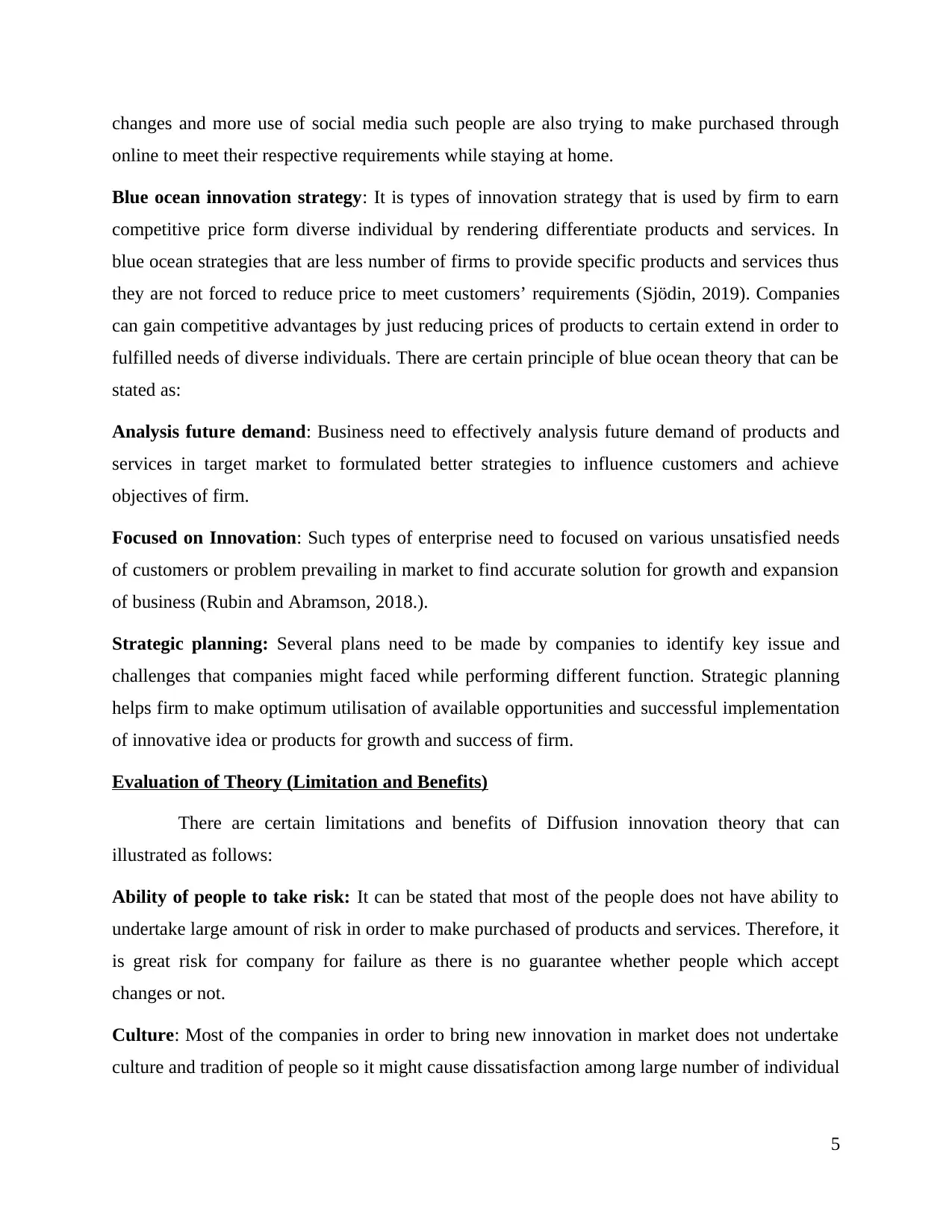
changes and more use of social media such people are also trying to make purchased through
online to meet their respective requirements while staying at home.
Blue ocean innovation strategy: It is types of innovation strategy that is used by firm to earn
competitive price form diverse individual by rendering differentiate products and services. In
blue ocean strategies that are less number of firms to provide specific products and services thus
they are not forced to reduce price to meet customers’ requirements (Sjödin, 2019). Companies
can gain competitive advantages by just reducing prices of products to certain extend in order to
fulfilled needs of diverse individuals. There are certain principle of blue ocean theory that can be
stated as:
Analysis future demand: Business need to effectively analysis future demand of products and
services in target market to formulated better strategies to influence customers and achieve
objectives of firm.
Focused on Innovation: Such types of enterprise need to focused on various unsatisfied needs
of customers or problem prevailing in market to find accurate solution for growth and expansion
of business (Rubin and Abramson, 2018.).
Strategic planning: Several plans need to be made by companies to identify key issue and
challenges that companies might faced while performing different function. Strategic planning
helps firm to make optimum utilisation of available opportunities and successful implementation
of innovative idea or products for growth and success of firm.
Evaluation of Theory (Limitation and Benefits)
There are certain limitations and benefits of Diffusion innovation theory that can
illustrated as follows:
Ability of people to take risk: It can be stated that most of the people does not have ability to
undertake large amount of risk in order to make purchased of products and services. Therefore, it
is great risk for company for failure as there is no guarantee whether people which accept
changes or not.
Culture: Most of the companies in order to bring new innovation in market does not undertake
culture and tradition of people so it might cause dissatisfaction among large number of individual
5
online to meet their respective requirements while staying at home.
Blue ocean innovation strategy: It is types of innovation strategy that is used by firm to earn
competitive price form diverse individual by rendering differentiate products and services. In
blue ocean strategies that are less number of firms to provide specific products and services thus
they are not forced to reduce price to meet customers’ requirements (Sjödin, 2019). Companies
can gain competitive advantages by just reducing prices of products to certain extend in order to
fulfilled needs of diverse individuals. There are certain principle of blue ocean theory that can be
stated as:
Analysis future demand: Business need to effectively analysis future demand of products and
services in target market to formulated better strategies to influence customers and achieve
objectives of firm.
Focused on Innovation: Such types of enterprise need to focused on various unsatisfied needs
of customers or problem prevailing in market to find accurate solution for growth and expansion
of business (Rubin and Abramson, 2018.).
Strategic planning: Several plans need to be made by companies to identify key issue and
challenges that companies might faced while performing different function. Strategic planning
helps firm to make optimum utilisation of available opportunities and successful implementation
of innovative idea or products for growth and success of firm.
Evaluation of Theory (Limitation and Benefits)
There are certain limitations and benefits of Diffusion innovation theory that can
illustrated as follows:
Ability of people to take risk: It can be stated that most of the people does not have ability to
undertake large amount of risk in order to make purchased of products and services. Therefore, it
is great risk for company for failure as there is no guarantee whether people which accept
changes or not.
Culture: Most of the companies in order to bring new innovation in market does not undertake
culture and tradition of people so it might cause dissatisfaction among large number of individual
5
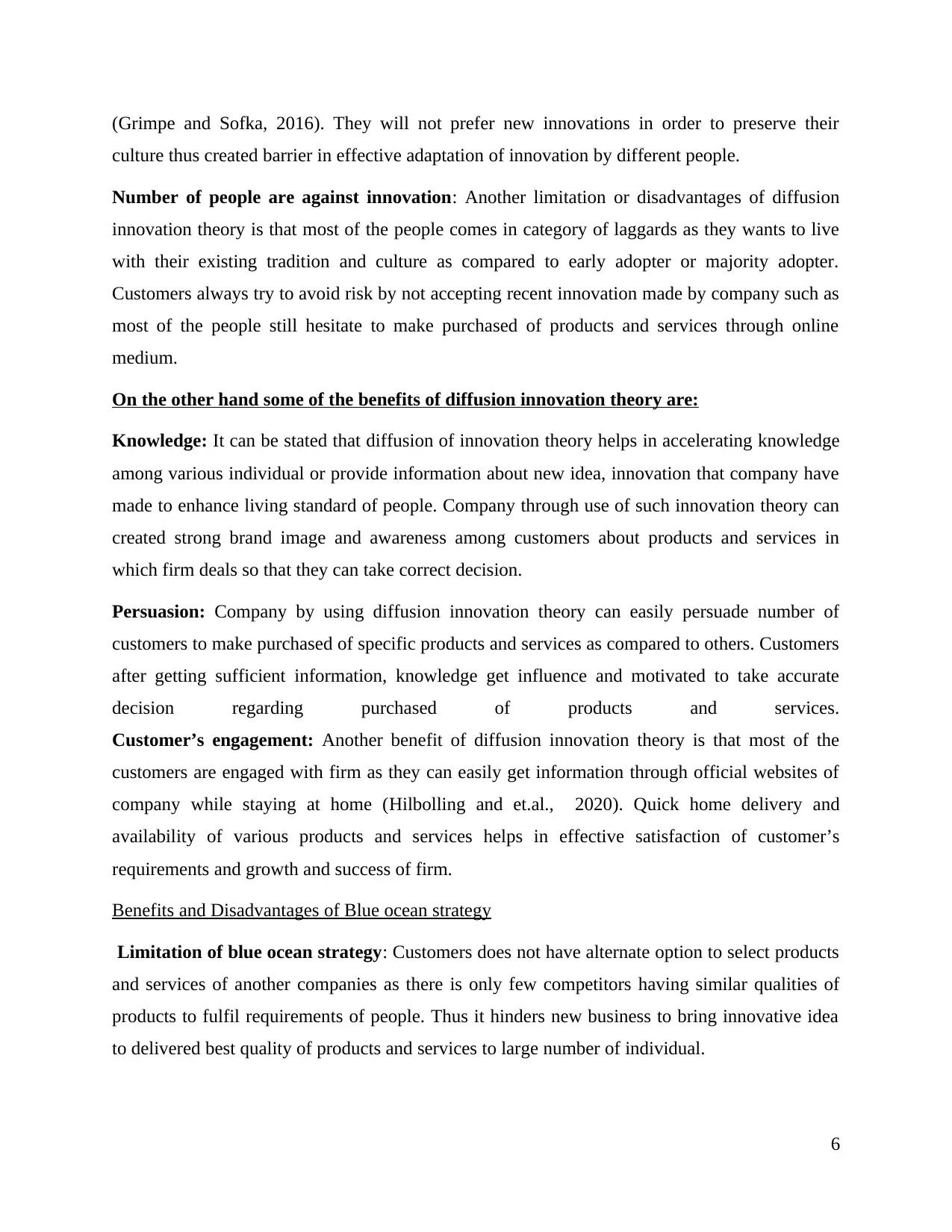
(Grimpe and Sofka, 2016). They will not prefer new innovations in order to preserve their
culture thus created barrier in effective adaptation of innovation by different people.
Number of people are against innovation: Another limitation or disadvantages of diffusion
innovation theory is that most of the people comes in category of laggards as they wants to live
with their existing tradition and culture as compared to early adopter or majority adopter.
Customers always try to avoid risk by not accepting recent innovation made by company such as
most of the people still hesitate to make purchased of products and services through online
medium.
On the other hand some of the benefits of diffusion innovation theory are:
Knowledge: It can be stated that diffusion of innovation theory helps in accelerating knowledge
among various individual or provide information about new idea, innovation that company have
made to enhance living standard of people. Company through use of such innovation theory can
created strong brand image and awareness among customers about products and services in
which firm deals so that they can take correct decision.
Persuasion: Company by using diffusion innovation theory can easily persuade number of
customers to make purchased of specific products and services as compared to others. Customers
after getting sufficient information, knowledge get influence and motivated to take accurate
decision regarding purchased of products and services.
Customer’s engagement: Another benefit of diffusion innovation theory is that most of the
customers are engaged with firm as they can easily get information through official websites of
company while staying at home (Hilbolling and et.al., 2020). Quick home delivery and
availability of various products and services helps in effective satisfaction of customer’s
requirements and growth and success of firm.
Benefits and Disadvantages of Blue ocean strategy
Limitation of blue ocean strategy: Customers does not have alternate option to select products
and services of another companies as there is only few competitors having similar qualities of
products to fulfil requirements of people. Thus it hinders new business to bring innovative idea
to delivered best quality of products and services to large number of individual.
6
culture thus created barrier in effective adaptation of innovation by different people.
Number of people are against innovation: Another limitation or disadvantages of diffusion
innovation theory is that most of the people comes in category of laggards as they wants to live
with their existing tradition and culture as compared to early adopter or majority adopter.
Customers always try to avoid risk by not accepting recent innovation made by company such as
most of the people still hesitate to make purchased of products and services through online
medium.
On the other hand some of the benefits of diffusion innovation theory are:
Knowledge: It can be stated that diffusion of innovation theory helps in accelerating knowledge
among various individual or provide information about new idea, innovation that company have
made to enhance living standard of people. Company through use of such innovation theory can
created strong brand image and awareness among customers about products and services in
which firm deals so that they can take correct decision.
Persuasion: Company by using diffusion innovation theory can easily persuade number of
customers to make purchased of specific products and services as compared to others. Customers
after getting sufficient information, knowledge get influence and motivated to take accurate
decision regarding purchased of products and services.
Customer’s engagement: Another benefit of diffusion innovation theory is that most of the
customers are engaged with firm as they can easily get information through official websites of
company while staying at home (Hilbolling and et.al., 2020). Quick home delivery and
availability of various products and services helps in effective satisfaction of customer’s
requirements and growth and success of firm.
Benefits and Disadvantages of Blue ocean strategy
Limitation of blue ocean strategy: Customers does not have alternate option to select products
and services of another companies as there is only few competitors having similar qualities of
products to fulfil requirements of people. Thus it hinders new business to bring innovative idea
to delivered best quality of products and services to large number of individual.
6
⊘ This is a preview!⊘
Do you want full access?
Subscribe today to unlock all pages.

Trusted by 1+ million students worldwide
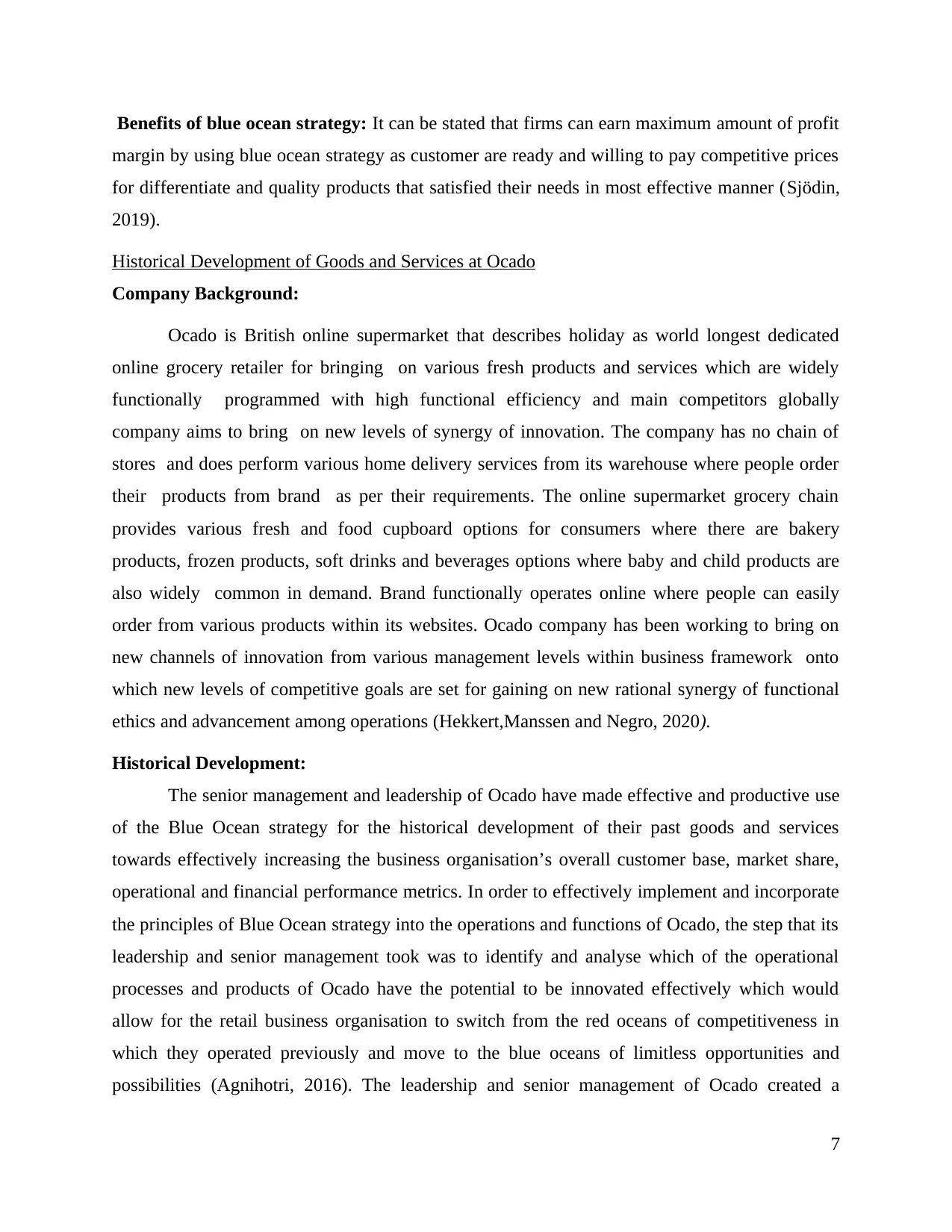
Benefits of blue ocean strategy: It can be stated that firms can earn maximum amount of profit
margin by using blue ocean strategy as customer are ready and willing to pay competitive prices
for differentiate and quality products that satisfied their needs in most effective manner (Sjödin,
2019).
Historical Development of Goods and Services at Ocado
Company Background:
Ocado is British online supermarket that describes holiday as world longest dedicated
online grocery retailer for bringing on various fresh products and services which are widely
functionally programmed with high functional efficiency and main competitors globally
company aims to bring on new levels of synergy of innovation. The company has no chain of
stores and does perform various home delivery services from its warehouse where people order
their products from brand as per their requirements. The online supermarket grocery chain
provides various fresh and food cupboard options for consumers where there are bakery
products, frozen products, soft drinks and beverages options where baby and child products are
also widely common in demand. Brand functionally operates online where people can easily
order from various products within its websites. Ocado company has been working to bring on
new channels of innovation from various management levels within business framework onto
which new levels of competitive goals are set for gaining on new rational synergy of functional
ethics and advancement among operations (Hekkert,Manssen and Negro, 2020).
Historical Development:
The senior management and leadership of Ocado have made effective and productive use
of the Blue Ocean strategy for the historical development of their past goods and services
towards effectively increasing the business organisation’s overall customer base, market share,
operational and financial performance metrics. In order to effectively implement and incorporate
the principles of Blue Ocean strategy into the operations and functions of Ocado, the step that its
leadership and senior management took was to identify and analyse which of the operational
processes and products of Ocado have the potential to be innovated effectively which would
allow for the retail business organisation to switch from the red oceans of competitiveness in
which they operated previously and move to the blue oceans of limitless opportunities and
possibilities (Agnihotri, 2016). The leadership and senior management of Ocado created a
7
margin by using blue ocean strategy as customer are ready and willing to pay competitive prices
for differentiate and quality products that satisfied their needs in most effective manner (Sjödin,
2019).
Historical Development of Goods and Services at Ocado
Company Background:
Ocado is British online supermarket that describes holiday as world longest dedicated
online grocery retailer for bringing on various fresh products and services which are widely
functionally programmed with high functional efficiency and main competitors globally
company aims to bring on new levels of synergy of innovation. The company has no chain of
stores and does perform various home delivery services from its warehouse where people order
their products from brand as per their requirements. The online supermarket grocery chain
provides various fresh and food cupboard options for consumers where there are bakery
products, frozen products, soft drinks and beverages options where baby and child products are
also widely common in demand. Brand functionally operates online where people can easily
order from various products within its websites. Ocado company has been working to bring on
new channels of innovation from various management levels within business framework onto
which new levels of competitive goals are set for gaining on new rational synergy of functional
ethics and advancement among operations (Hekkert,Manssen and Negro, 2020).
Historical Development:
The senior management and leadership of Ocado have made effective and productive use
of the Blue Ocean strategy for the historical development of their past goods and services
towards effectively increasing the business organisation’s overall customer base, market share,
operational and financial performance metrics. In order to effectively implement and incorporate
the principles of Blue Ocean strategy into the operations and functions of Ocado, the step that its
leadership and senior management took was to identify and analyse which of the operational
processes and products of Ocado have the potential to be innovated effectively which would
allow for the retail business organisation to switch from the red oceans of competitiveness in
which they operated previously and move to the blue oceans of limitless opportunities and
possibilities (Agnihotri, 2016). The leadership and senior management of Ocado created a
7
Paraphrase This Document
Need a fresh take? Get an instant paraphrase of this document with our AI Paraphraser
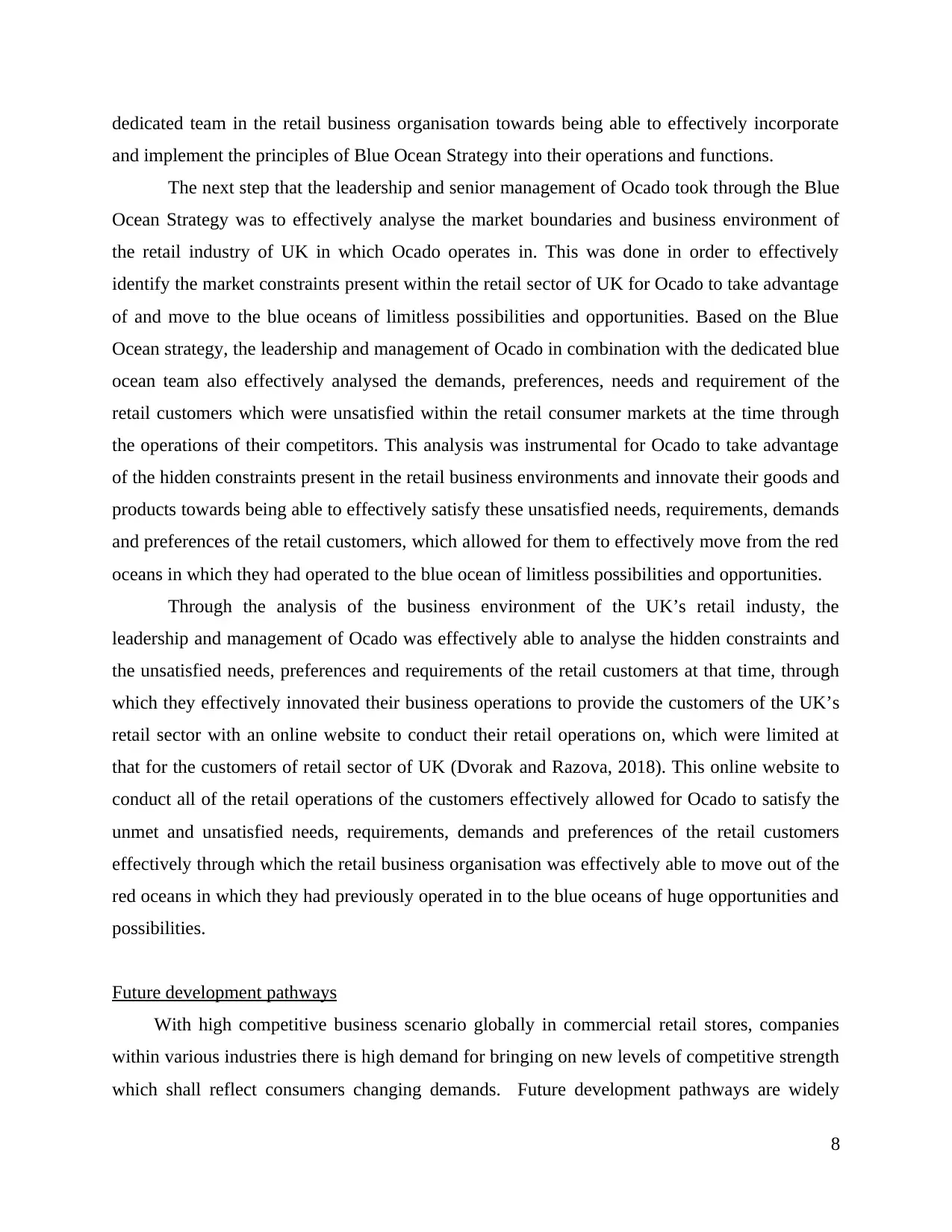
dedicated team in the retail business organisation towards being able to effectively incorporate
and implement the principles of Blue Ocean Strategy into their operations and functions.
The next step that the leadership and senior management of Ocado took through the Blue
Ocean Strategy was to effectively analyse the market boundaries and business environment of
the retail industry of UK in which Ocado operates in. This was done in order to effectively
identify the market constraints present within the retail sector of UK for Ocado to take advantage
of and move to the blue oceans of limitless possibilities and opportunities. Based on the Blue
Ocean strategy, the leadership and management of Ocado in combination with the dedicated blue
ocean team also effectively analysed the demands, preferences, needs and requirement of the
retail customers which were unsatisfied within the retail consumer markets at the time through
the operations of their competitors. This analysis was instrumental for Ocado to take advantage
of the hidden constraints present in the retail business environments and innovate their goods and
products towards being able to effectively satisfy these unsatisfied needs, requirements, demands
and preferences of the retail customers, which allowed for them to effectively move from the red
oceans in which they had operated to the blue ocean of limitless possibilities and opportunities.
Through the analysis of the business environment of the UK’s retail industy, the
leadership and management of Ocado was effectively able to analyse the hidden constraints and
the unsatisfied needs, preferences and requirements of the retail customers at that time, through
which they effectively innovated their business operations to provide the customers of the UK’s
retail sector with an online website to conduct their retail operations on, which were limited at
that for the customers of retail sector of UK (Dvorak and Razova, 2018). This online website to
conduct all of the retail operations of the customers effectively allowed for Ocado to satisfy the
unmet and unsatisfied needs, requirements, demands and preferences of the retail customers
effectively through which the retail business organisation was effectively able to move out of the
red oceans in which they had previously operated in to the blue oceans of huge opportunities and
possibilities.
Future development pathways
With high competitive business scenario globally in commercial retail stores, companies
within various industries there is high demand for bringing on new levels of competitive strength
which shall reflect consumers changing demands. Future development pathways are widely
8
and implement the principles of Blue Ocean Strategy into their operations and functions.
The next step that the leadership and senior management of Ocado took through the Blue
Ocean Strategy was to effectively analyse the market boundaries and business environment of
the retail industry of UK in which Ocado operates in. This was done in order to effectively
identify the market constraints present within the retail sector of UK for Ocado to take advantage
of and move to the blue oceans of limitless possibilities and opportunities. Based on the Blue
Ocean strategy, the leadership and management of Ocado in combination with the dedicated blue
ocean team also effectively analysed the demands, preferences, needs and requirement of the
retail customers which were unsatisfied within the retail consumer markets at the time through
the operations of their competitors. This analysis was instrumental for Ocado to take advantage
of the hidden constraints present in the retail business environments and innovate their goods and
products towards being able to effectively satisfy these unsatisfied needs, requirements, demands
and preferences of the retail customers, which allowed for them to effectively move from the red
oceans in which they had operated to the blue ocean of limitless possibilities and opportunities.
Through the analysis of the business environment of the UK’s retail industy, the
leadership and management of Ocado was effectively able to analyse the hidden constraints and
the unsatisfied needs, preferences and requirements of the retail customers at that time, through
which they effectively innovated their business operations to provide the customers of the UK’s
retail sector with an online website to conduct their retail operations on, which were limited at
that for the customers of retail sector of UK (Dvorak and Razova, 2018). This online website to
conduct all of the retail operations of the customers effectively allowed for Ocado to satisfy the
unmet and unsatisfied needs, requirements, demands and preferences of the retail customers
effectively through which the retail business organisation was effectively able to move out of the
red oceans in which they had previously operated in to the blue oceans of huge opportunities and
possibilities.
Future development pathways
With high competitive business scenario globally in commercial retail stores, companies
within various industries there is high demand for bringing on new levels of competitive strength
which shall reflect consumers changing demands. Future development pathways are widely
8
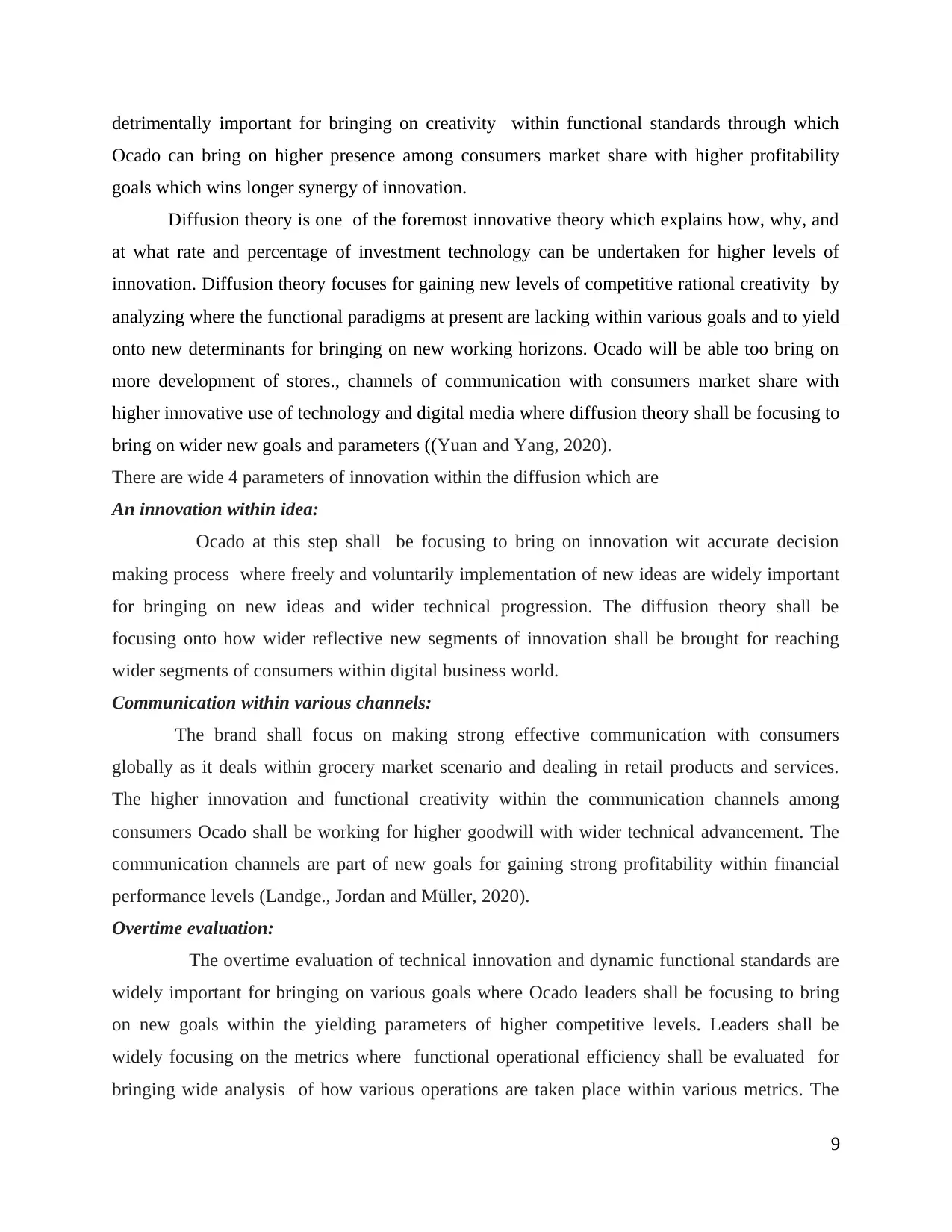
detrimentally important for bringing on creativity within functional standards through which
Ocado can bring on higher presence among consumers market share with higher profitability
goals which wins longer synergy of innovation.
Diffusion theory is one of the foremost innovative theory which explains how, why, and
at what rate and percentage of investment technology can be undertaken for higher levels of
innovation. Diffusion theory focuses for gaining new levels of competitive rational creativity by
analyzing where the functional paradigms at present are lacking within various goals and to yield
onto new determinants for bringing on new working horizons. Ocado will be able too bring on
more development of stores., channels of communication with consumers market share with
higher innovative use of technology and digital media where diffusion theory shall be focusing to
bring on wider new goals and parameters ((Yuan and Yang, 2020).
There are wide 4 parameters of innovation within the diffusion which are
An innovation within idea:
Ocado at this step shall be focusing to bring on innovation wit accurate decision
making process where freely and voluntarily implementation of new ideas are widely important
for bringing on new ideas and wider technical progression. The diffusion theory shall be
focusing onto how wider reflective new segments of innovation shall be brought for reaching
wider segments of consumers within digital business world.
Communication within various channels:
The brand shall focus on making strong effective communication with consumers
globally as it deals within grocery market scenario and dealing in retail products and services.
The higher innovation and functional creativity within the communication channels among
consumers Ocado shall be working for higher goodwill with wider technical advancement. The
communication channels are part of new goals for gaining strong profitability within financial
performance levels (Landge., Jordan and Müller, 2020).
Overtime evaluation:
The overtime evaluation of technical innovation and dynamic functional standards are
widely important for bringing on various goals where Ocado leaders shall be focusing to bring
on new goals within the yielding parameters of higher competitive levels. Leaders shall be
widely focusing on the metrics where functional operational efficiency shall be evaluated for
bringing wide analysis of how various operations are taken place within various metrics. The
9
Ocado can bring on higher presence among consumers market share with higher profitability
goals which wins longer synergy of innovation.
Diffusion theory is one of the foremost innovative theory which explains how, why, and
at what rate and percentage of investment technology can be undertaken for higher levels of
innovation. Diffusion theory focuses for gaining new levels of competitive rational creativity by
analyzing where the functional paradigms at present are lacking within various goals and to yield
onto new determinants for bringing on new working horizons. Ocado will be able too bring on
more development of stores., channels of communication with consumers market share with
higher innovative use of technology and digital media where diffusion theory shall be focusing to
bring on wider new goals and parameters ((Yuan and Yang, 2020).
There are wide 4 parameters of innovation within the diffusion which are
An innovation within idea:
Ocado at this step shall be focusing to bring on innovation wit accurate decision
making process where freely and voluntarily implementation of new ideas are widely important
for bringing on new ideas and wider technical progression. The diffusion theory shall be
focusing onto how wider reflective new segments of innovation shall be brought for reaching
wider segments of consumers within digital business world.
Communication within various channels:
The brand shall focus on making strong effective communication with consumers
globally as it deals within grocery market scenario and dealing in retail products and services.
The higher innovation and functional creativity within the communication channels among
consumers Ocado shall be working for higher goodwill with wider technical advancement. The
communication channels are part of new goals for gaining strong profitability within financial
performance levels (Landge., Jordan and Müller, 2020).
Overtime evaluation:
The overtime evaluation of technical innovation and dynamic functional standards are
widely important for bringing on various goals where Ocado leaders shall be focusing to bring
on new goals within the yielding parameters of higher competitive levels. Leaders shall be
widely focusing on the metrics where functional operational efficiency shall be evaluated for
bringing wide analysis of how various operations are taken place within various metrics. The
9
⊘ This is a preview!⊘
Do you want full access?
Subscribe today to unlock all pages.

Trusted by 1+ million students worldwide
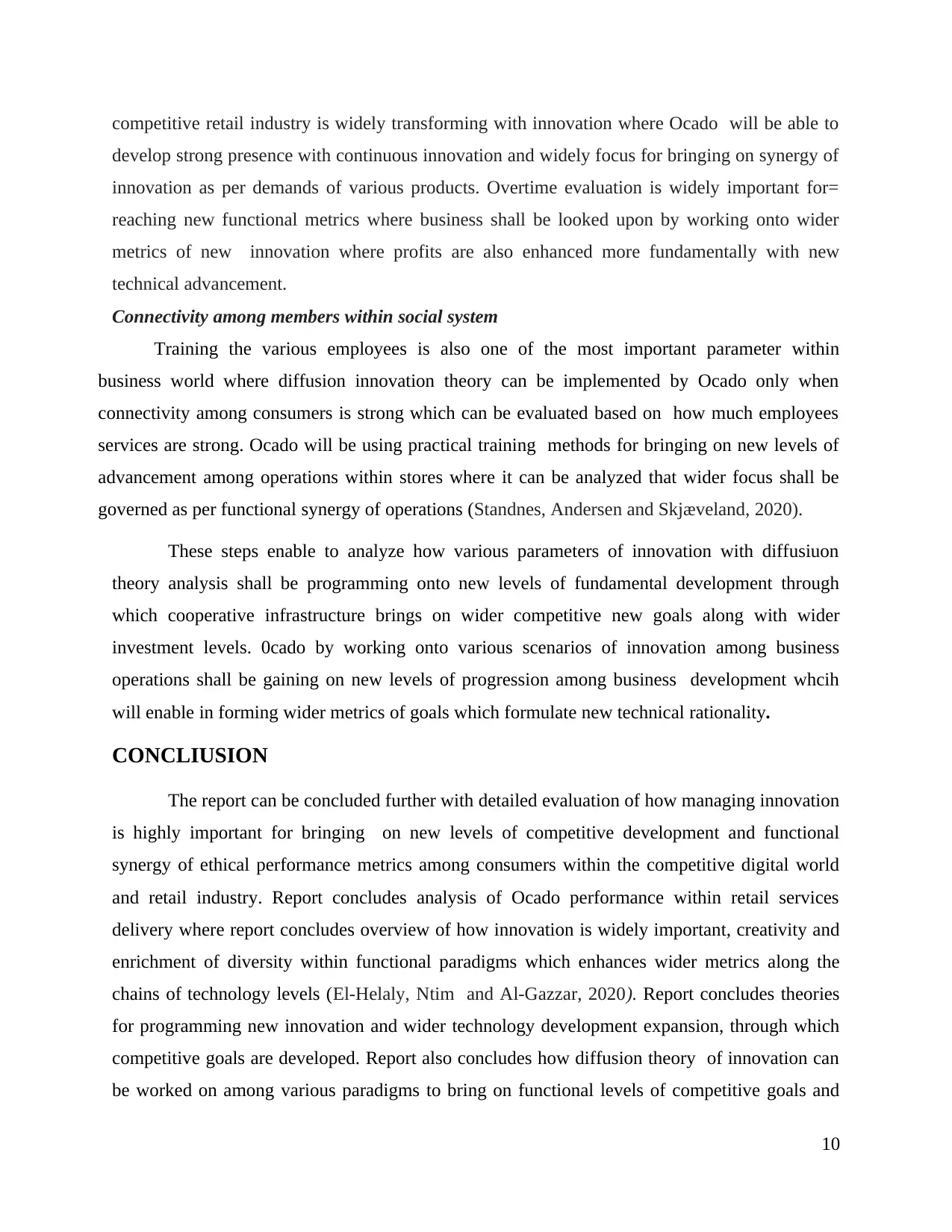
competitive retail industry is widely transforming with innovation where Ocado will be able to
develop strong presence with continuous innovation and widely focus for bringing on synergy of
innovation as per demands of various products. Overtime evaluation is widely important for=
reaching new functional metrics where business shall be looked upon by working onto wider
metrics of new innovation where profits are also enhanced more fundamentally with new
technical advancement.
Connectivity among members within social system
Training the various employees is also one of the most important parameter within
business world where diffusion innovation theory can be implemented by Ocado only when
connectivity among consumers is strong which can be evaluated based on how much employees
services are strong. Ocado will be using practical training methods for bringing on new levels of
advancement among operations within stores where it can be analyzed that wider focus shall be
governed as per functional synergy of operations (Standnes, Andersen and Skjæveland, 2020).
These steps enable to analyze how various parameters of innovation with diffusiuon
theory analysis shall be programming onto new levels of fundamental development through
which cooperative infrastructure brings on wider competitive new goals along with wider
investment levels. 0cado by working onto various scenarios of innovation among business
operations shall be gaining on new levels of progression among business development whcih
will enable in forming wider metrics of goals which formulate new technical rationality.
CONCLIUSION
The report can be concluded further with detailed evaluation of how managing innovation
is highly important for bringing on new levels of competitive development and functional
synergy of ethical performance metrics among consumers within the competitive digital world
and retail industry. Report concludes analysis of Ocado performance within retail services
delivery where report concludes overview of how innovation is widely important, creativity and
enrichment of diversity within functional paradigms which enhances wider metrics along the
chains of technology levels (El-Helaly, Ntim and Al-Gazzar, 2020). Report concludes theories
for programming new innovation and wider technology development expansion, through which
competitive goals are developed. Report also concludes how diffusion theory of innovation can
be worked on among various paradigms to bring on functional levels of competitive goals and
10
develop strong presence with continuous innovation and widely focus for bringing on synergy of
innovation as per demands of various products. Overtime evaluation is widely important for=
reaching new functional metrics where business shall be looked upon by working onto wider
metrics of new innovation where profits are also enhanced more fundamentally with new
technical advancement.
Connectivity among members within social system
Training the various employees is also one of the most important parameter within
business world where diffusion innovation theory can be implemented by Ocado only when
connectivity among consumers is strong which can be evaluated based on how much employees
services are strong. Ocado will be using practical training methods for bringing on new levels of
advancement among operations within stores where it can be analyzed that wider focus shall be
governed as per functional synergy of operations (Standnes, Andersen and Skjæveland, 2020).
These steps enable to analyze how various parameters of innovation with diffusiuon
theory analysis shall be programming onto new levels of fundamental development through
which cooperative infrastructure brings on wider competitive new goals along with wider
investment levels. 0cado by working onto various scenarios of innovation among business
operations shall be gaining on new levels of progression among business development whcih
will enable in forming wider metrics of goals which formulate new technical rationality.
CONCLIUSION
The report can be concluded further with detailed evaluation of how managing innovation
is highly important for bringing on new levels of competitive development and functional
synergy of ethical performance metrics among consumers within the competitive digital world
and retail industry. Report concludes analysis of Ocado performance within retail services
delivery where report concludes overview of how innovation is widely important, creativity and
enrichment of diversity within functional paradigms which enhances wider metrics along the
chains of technology levels (El-Helaly, Ntim and Al-Gazzar, 2020). Report concludes theories
for programming new innovation and wider technology development expansion, through which
competitive goals are developed. Report also concludes how diffusion theory of innovation can
be worked on among various paradigms to bring on functional levels of competitive goals and
10
Paraphrase This Document
Need a fresh take? Get an instant paraphrase of this document with our AI Paraphraser
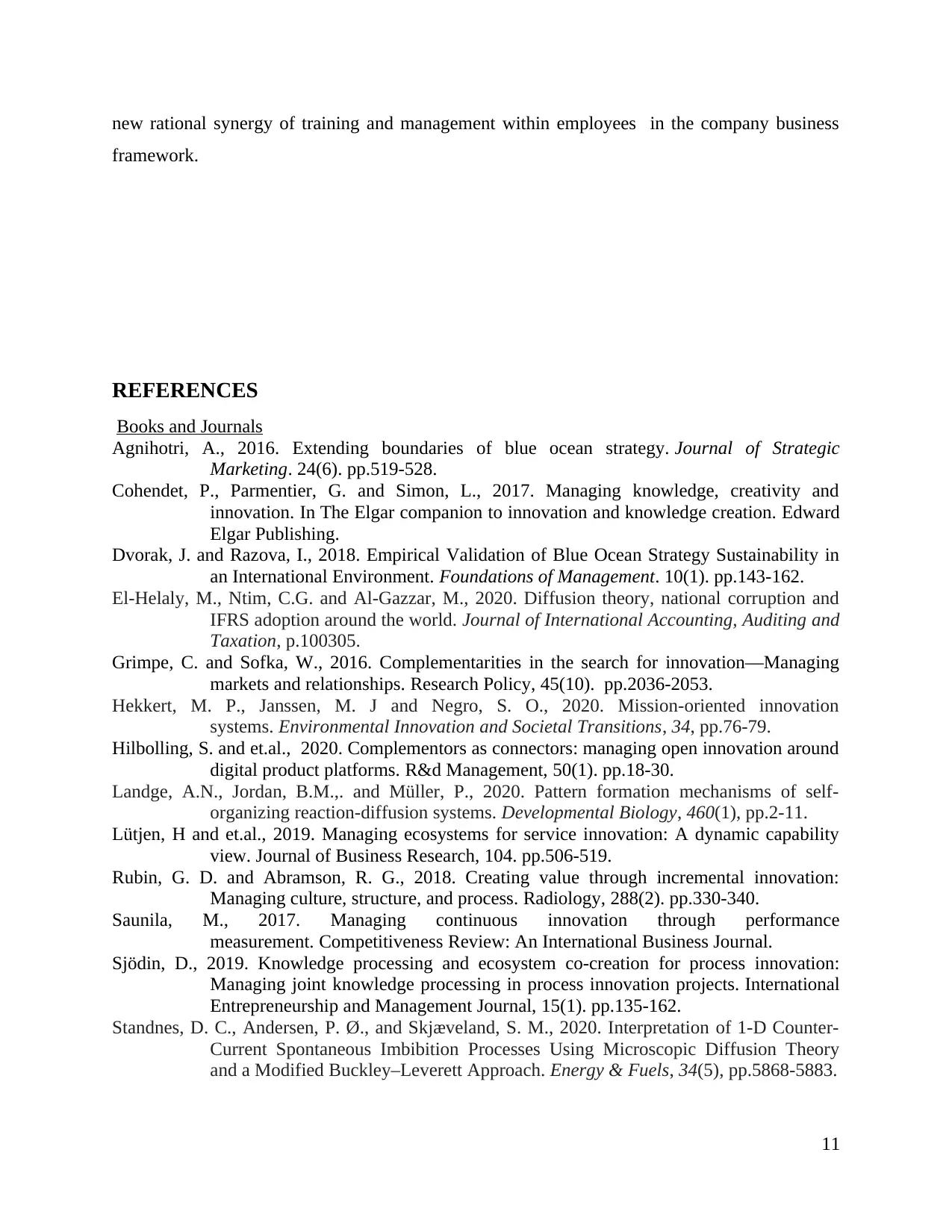
new rational synergy of training and management within employees in the company business
framework.
REFERENCES
Books and Journals
Agnihotri, A., 2016. Extending boundaries of blue ocean strategy. Journal of Strategic
Marketing. 24(6). pp.519-528.
Cohendet, P., Parmentier, G. and Simon, L., 2017. Managing knowledge, creativity and
innovation. In The Elgar companion to innovation and knowledge creation. Edward
Elgar Publishing.
Dvorak, J. and Razova, I., 2018. Empirical Validation of Blue Ocean Strategy Sustainability in
an International Environment. Foundations of Management. 10(1). pp.143-162.
El-Helaly, M., Ntim, C.G. and Al-Gazzar, M., 2020. Diffusion theory, national corruption and
IFRS adoption around the world. Journal of International Accounting, Auditing and
Taxation, p.100305.
Grimpe, C. and Sofka, W., 2016. Complementarities in the search for innovation—Managing
markets and relationships. Research Policy, 45(10). pp.2036-2053.
Hekkert, M. P., Janssen, M. J and Negro, S. O., 2020. Mission-oriented innovation
systems. Environmental Innovation and Societal Transitions, 34, pp.76-79.
Hilbolling, S. and et.al., 2020. Complementors as connectors: managing open innovation around
digital product platforms. R&d Management, 50(1). pp.18-30.
Landge, A.N., Jordan, B.M.,. and Müller, P., 2020. Pattern formation mechanisms of self-
organizing reaction-diffusion systems. Developmental Biology, 460(1), pp.2-11.
Lütjen, H and et.al., 2019. Managing ecosystems for service innovation: A dynamic capability
view. Journal of Business Research, 104. pp.506-519.
Rubin, G. D. and Abramson, R. G., 2018. Creating value through incremental innovation:
Managing culture, structure, and process. Radiology, 288(2). pp.330-340.
Saunila, M., 2017. Managing continuous innovation through performance
measurement. Competitiveness Review: An International Business Journal.
Sjödin, D., 2019. Knowledge processing and ecosystem co-creation for process innovation:
Managing joint knowledge processing in process innovation projects. International
Entrepreneurship and Management Journal, 15(1). pp.135-162.
Standnes, D. C., Andersen, P. Ø., and Skjæveland, S. M., 2020. Interpretation of 1-D Counter-
Current Spontaneous Imbibition Processes Using Microscopic Diffusion Theory
and a Modified Buckley–Leverett Approach. Energy & Fuels, 34(5), pp.5868-5883.
11
framework.
REFERENCES
Books and Journals
Agnihotri, A., 2016. Extending boundaries of blue ocean strategy. Journal of Strategic
Marketing. 24(6). pp.519-528.
Cohendet, P., Parmentier, G. and Simon, L., 2017. Managing knowledge, creativity and
innovation. In The Elgar companion to innovation and knowledge creation. Edward
Elgar Publishing.
Dvorak, J. and Razova, I., 2018. Empirical Validation of Blue Ocean Strategy Sustainability in
an International Environment. Foundations of Management. 10(1). pp.143-162.
El-Helaly, M., Ntim, C.G. and Al-Gazzar, M., 2020. Diffusion theory, national corruption and
IFRS adoption around the world. Journal of International Accounting, Auditing and
Taxation, p.100305.
Grimpe, C. and Sofka, W., 2016. Complementarities in the search for innovation—Managing
markets and relationships. Research Policy, 45(10). pp.2036-2053.
Hekkert, M. P., Janssen, M. J and Negro, S. O., 2020. Mission-oriented innovation
systems. Environmental Innovation and Societal Transitions, 34, pp.76-79.
Hilbolling, S. and et.al., 2020. Complementors as connectors: managing open innovation around
digital product platforms. R&d Management, 50(1). pp.18-30.
Landge, A.N., Jordan, B.M.,. and Müller, P., 2020. Pattern formation mechanisms of self-
organizing reaction-diffusion systems. Developmental Biology, 460(1), pp.2-11.
Lütjen, H and et.al., 2019. Managing ecosystems for service innovation: A dynamic capability
view. Journal of Business Research, 104. pp.506-519.
Rubin, G. D. and Abramson, R. G., 2018. Creating value through incremental innovation:
Managing culture, structure, and process. Radiology, 288(2). pp.330-340.
Saunila, M., 2017. Managing continuous innovation through performance
measurement. Competitiveness Review: An International Business Journal.
Sjödin, D., 2019. Knowledge processing and ecosystem co-creation for process innovation:
Managing joint knowledge processing in process innovation projects. International
Entrepreneurship and Management Journal, 15(1). pp.135-162.
Standnes, D. C., Andersen, P. Ø., and Skjæveland, S. M., 2020. Interpretation of 1-D Counter-
Current Spontaneous Imbibition Processes Using Microscopic Diffusion Theory
and a Modified Buckley–Leverett Approach. Energy & Fuels, 34(5), pp.5868-5883.
11
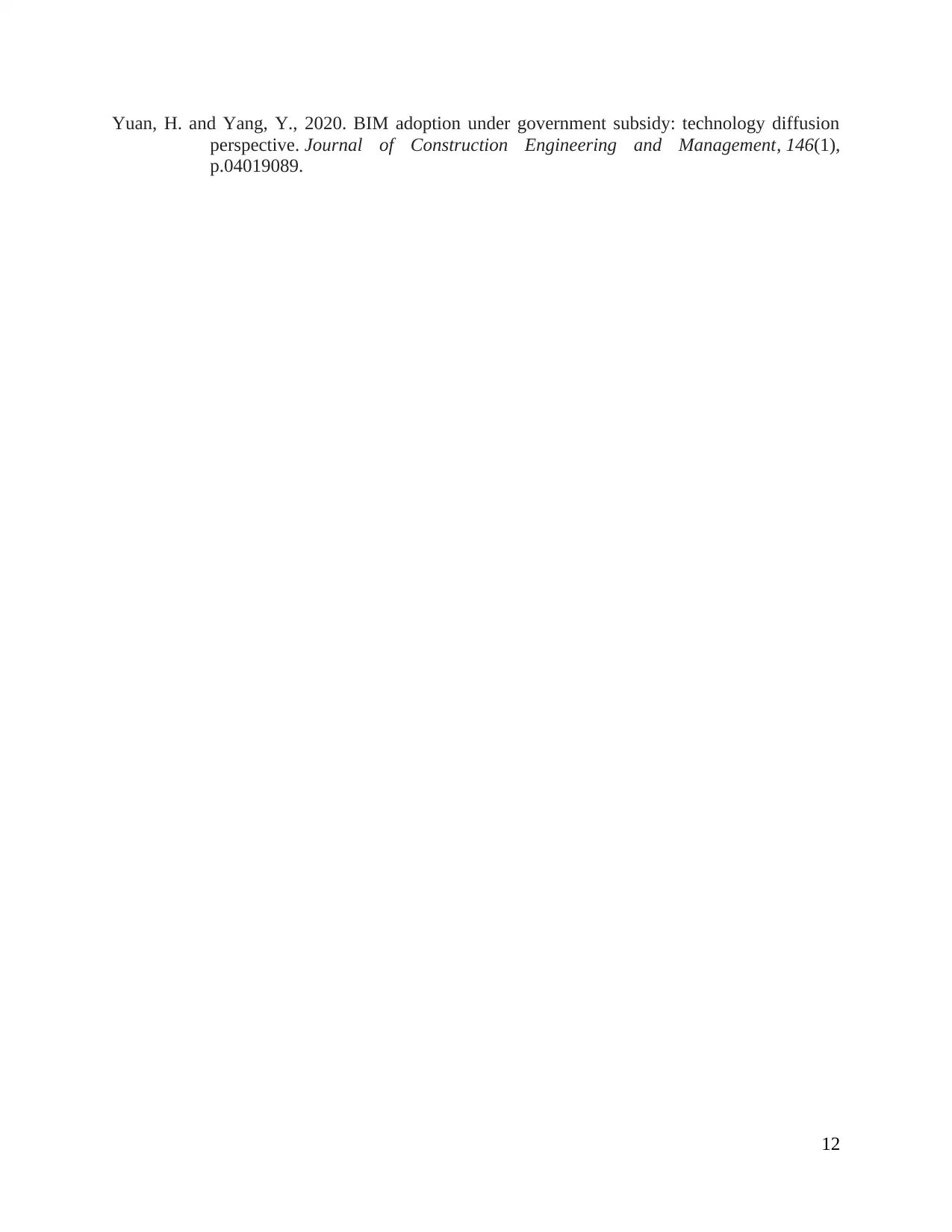
Yuan, H. and Yang, Y., 2020. BIM adoption under government subsidy: technology diffusion
perspective. Journal of Construction Engineering and Management, 146(1),
p.04019089.
12
perspective. Journal of Construction Engineering and Management, 146(1),
p.04019089.
12
⊘ This is a preview!⊘
Do you want full access?
Subscribe today to unlock all pages.

Trusted by 1+ million students worldwide
1 out of 13
Related Documents
Your All-in-One AI-Powered Toolkit for Academic Success.
+13062052269
info@desklib.com
Available 24*7 on WhatsApp / Email
![[object Object]](/_next/static/media/star-bottom.7253800d.svg)
Unlock your academic potential
Copyright © 2020–2025 A2Z Services. All Rights Reserved. Developed and managed by ZUCOL.





